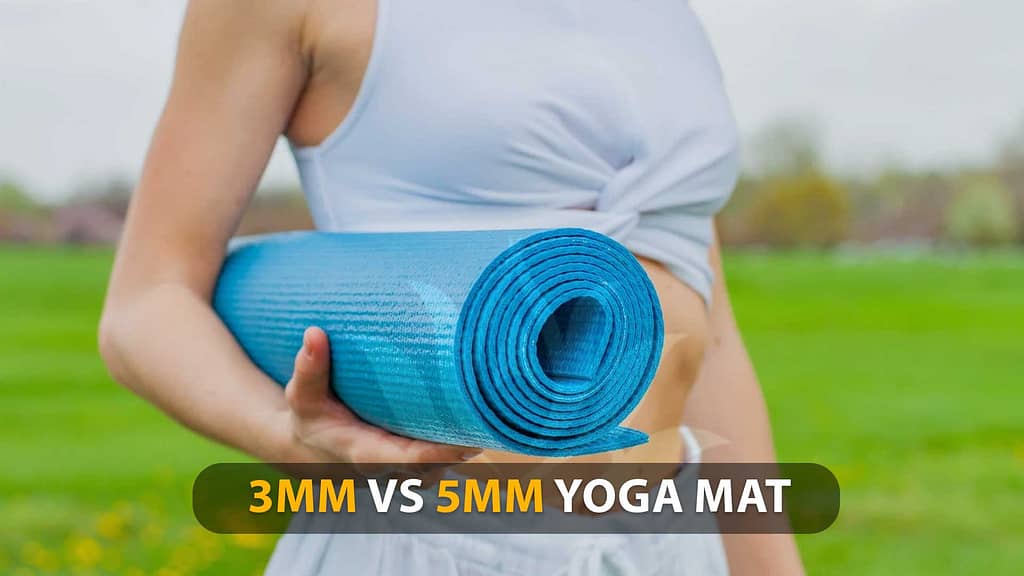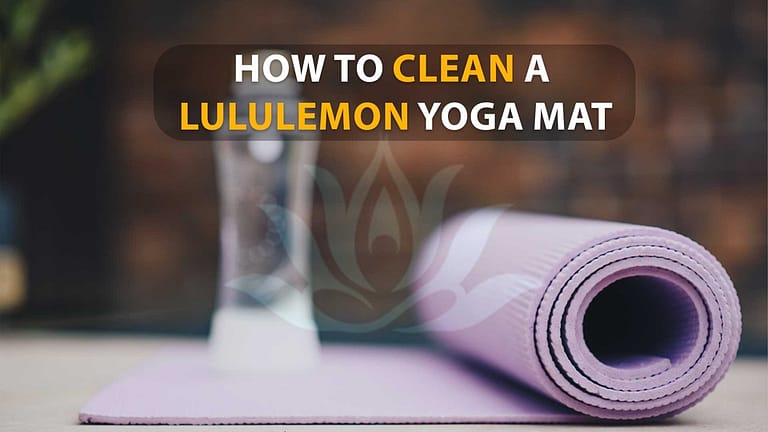3mm vs 5mm Yoga Mat: Which One Is Best For You In 2023

3mm vs 5mm Yoga Mat
As we all know, a yoga mat plays a vital role in yoga practice. There are different sizes of yoga mats available in markets. When picking a yoga mat, one of the most important things is figuring out which style is best for your body.
Many yoga mats are usually between 4 and 5 mm thick. These mats have a good mix of comfort and stability, so they are good for most people, even beginners. Our blog post will discuss 3mm vs 5mm yoga mats and how to choose them.
Yoga Style
When deciding between yoga mat sizes, one of the most important things to consider is what kind of yoga you like. Many people like to switch things up and do different kinds of yoga, so they have a few different mats for each style
For example, if you like restorative yoga or yoga that have you sit or kneel a lot, you might want a bigger mat. When you’re in these poses, a thicker mat can give your body more support to stay in them longer without pain.
On the other hand, you may like more active yoga flows and often go to fast-paced classes full of balance and stability poses. If that’s the case, you might be better off with a smaller mat.
Due to the extra cushioning, thicker mats can make it harder to keep your balance, so they are generally not the best choice for active flows.
Of course, a bigger mat works better for some flows because you need more joint support. You’ll have to figure out what works for you.
You can always buy a few yoga mats in different sizes and switch them out depending on the type of yoga you want to do. Because of this, a lot of yogis have more than one mat.
Read:
Can You Learn Ashtanga Yoga At Home? – Complete Guide In 2023
Is The Yoga Mat Worth It And Which One??

Thickness
Mats with more softness are better for sensitive joints or people who need extra support. On the other hand, thin mats are lighter and easy to move around.
Material
Most yoga mats are made of PVC, rubber, TPE, or natural fibers like jute or cotton. PVC mats last long and have a good grip, while rubber mats have a great grip. Natural fiber mats are better for the environment but may have a different grip or last as long.
Texture
Yoga mats with a rough surface or grip patterns can help keep you from falling, especially when you are sweaty. If you need more support, look for mats with a surface that doesn’t slip or that have extra grips.
Portability
If you want to carry your yoga mat to classes or take it with you, look for one that is light and easy to roll up and take with you.
Prices
Yoga mats vary greatly based on the brand, the materials used, and any extra features. Set a price limit and look for a mat that fits your price range and meets your needs.
Popular yoga mats makers like Manduka, Liforme, Jade Yoga, Gaiam, and Hugger Mugger, among others, make high-quality mats. But in the end, the best yoga mat for you relies on your own needs and tastes.
To find the one that works best for you, it can be good to read reviews, try out different mats if you can, and think about the things above.
Read:
Is It Okay To Wear Yoga Pants In Public? – Pros And Corns In 2023
Features Of Yoga Mat

First, we will discuss the features of both mats. Here are some of that given:
3mm Mats Features
The 3mm yoga mat is great because:
- It can be used for any kind of yoga.
- It’s great for standing poses, poses that make you feel more balanced, and poses that help you feel more linked to the floor.
- It’s thinner than the 5mm, so it’s great if you’re starting to do poses that require balance or if you’re in a class with a steady flow, like a Vinyasa class.
- You will find that the 3mm mat is lighter and easier to carry to and from class or the gym.
- Often, it costs less than thicker mats.
- Because the mat is thin, it might not be able to cushion or absorb shocks, as well as heavier mats.
- For poses that have you kneeling or lying down, a 3mm mat may be less comfy if your joints are sensitive or need more support.
- It also doesn’t keep out cold or hard surfaces.
Top 3mm Yoga Mats

Once you know how thick your mat should be, you can move on to choosing the best choice. If you want a 3mm thick mat, here are some options:
- Lululemon The Reversible Mat 3mm: This mat is famous because it doesn’t slip. It has a top layer that wicks away sweat and a bottom layer that grips the floor. It’s only 3mm thick but strong and gives a lot of support.
- The 1/8″ thick ProSourceFit Classic Yoga Mat: This yoga mat is made of PVC and gives people a lot of grip as they move through yoga flows. The mat is 72″ x 24″, which is great for tall people. The mat has enough padding without being too soft, but it is firm enough to help balance and support.
- Hugger Mugger Tapas Original Long Yoga Mat: Almost anyone can use this mat well. Because it is made of PVC, it has a sticky, non-slip surface, and the fact that it is 72″ x 24″ makes it a good choice for tall people.
Read:
Yoga Pants Bulge: Is It Acceptable To Show In Public In 2023
5mm Mats Features
The 5mm yoga mat is great because:
- The 5mm mat is better if you need more covering and cushion.
- This mat gives more support to your joints, like your arms, hips, back, and knees.
- The 5mm mat is thicker, which makes it great for sitting poses, therapeutic classes, yin classes, and meditation.
- Classes like Restorative and Yin yoga, where you sit or kneel often, work well with thicker mats.
- The extra padding also protects you from cold or hard floors.
- But When doing yoga poses, a thicker mat can make it feel less stable and balanced than a smaller mat.
- You might have to make some changes to keep the same amount of stability you have on a thinner mat.
- Also, 5mm mats are heavier and bigger, making them harder to carry.
Top 5mm Yoga Mats

If you choose a yoga mat that is 5 mm thick, the next step is to choose the right mat. There are a lot of choices, but some get better reviews than others. Here are some of the top-rated and best mats:
- Lululemon The Convertible Mat 5mm: This mat has a smooth, sticky polyurethane side for easy gripping and a soft natural rubber side for the best grip on the ground. This mat is great for bigger people because it is longer and wider and has more support for sore joints.
- Gaiam Dry Grip Performance Yoga Mat: This PVC mat is great for people who are allergic to latex or don’t like how rubber smells. There is a lot of cushioning for support, and the top layer is meant to keep you from slipping as you move through flows.
- The JadeYoga Harmony Mat: is a little 5mm thick (it’s 4 34 mm), but it’s a good choice if you’re looking for a mat around that size. It’s made entirely of rubber, which gives you a lot of grip as you move through each flow and is thick enough to give you enough support.
Read:
Does Yin Yoga Burn Calories? Benefits In 2023
What Yoga Mat Thickness Should I Get? 3 Mm Hurts My Back I Am A Beginner In Yoga

Many yoga mats are usually between 4 and 5 mm thick. These mats have a good mix of comfort and stability, so they are good for most people, even beginners.
You should get an extra thick mat if your back or joints need more protection. Most of these mats are between 6 mm and 8 mm thick, giving you more support and padding while you exercise.
Another choice is to use a yoga mat towel on top of your current mat. Most of the time, these towels are made of materials that can soak up water, like microfiber, and they can add extra padding and grip. They come in different sizes, so you can pick one that fits your back well.
Conclusion
There is no correct or incorrect response to this question. The best answer is the one that works for you. If you do most of your poses standing up, you’ll want a 3mm mat because it’s thinner and helps you keep your balance and steadiness.
If you mostly do sitting poses, meditation, restorative, or yin yoga, you’ll want a 5mm mat because it has more softness.
Whether you choose a 3mm or 5mm yoga mat depends on your preferences, needs, and the type of yoga you do. If you care most about stability, cost, and mobility, a 3mm mat might work. On the other hand, a 5mm mat would be better if you want more softness, support for your joints, and warmth.
FAQ’s
What Is The Best Thickness For A Yoga Mat?
To protect your knees, choose a mat that is between 5 and 8 mm thick. Another thing to look for is “how easy it is to transport,” so you can easily bring it to your lessons.
Is A 15mm Yoga Mat Thick?
Depending on their yoga type, some people use thicker mats. But even thick yoga mats can only go so far. Up to 6 mm (0.236 inches) is fine, but if you go any wider, you will lose the point of your practice.
How Dense Is A Yoga Mat That Is 10 Mm?
Gaiam’s 10mm (2/5 inch) mat is one of the biggest yoga mats. It can be used for fitness practices other than yoga because it is thick. Also, it’s great if you often train on a hard or uneven surface.
How To Choose The Perfect Yoga Mat Thickness?
A thicker mat (about 6mm) can give you more padding for gentle or restorative yoga. A thinner mat (around 3–5 mm) provides more support and connection to the ground for more active practices. Find the right balance between support and stability for your wants and preferences.
Is The Yoga Mat Worth It And Which One?
Indeed, a yoga mat is worth the money because it gives you support, traction, and stability while you do yoga. Some popular choices are the Liforme Yoga Mat, which is long-lasting and has alignment marks, and the Manduka PROlite Yoga Mat, which has thick padding and lasts a long time.
Read Also
- How To Clean A Lululemon Yoga Mat? – 5 Benefits Of Cleaning Lululemon Yoga Mat
- What Size Yoga Mat Do I Need? – 8 Important Factors For choosing Yoga Mat In 2023
- What Is The Ashtanga Yoga Of Patanjali? A Comprehensive Guide In 2023
- How Yoga Can Help You Live A Happy Life?
- Ashtanga Vs Hatha Yoga – Which Form Of Yoga Is Best In 2023
- What Is Special About Ashtanga Yoga? – 14 Benefits Of Ashtanga Yoga





